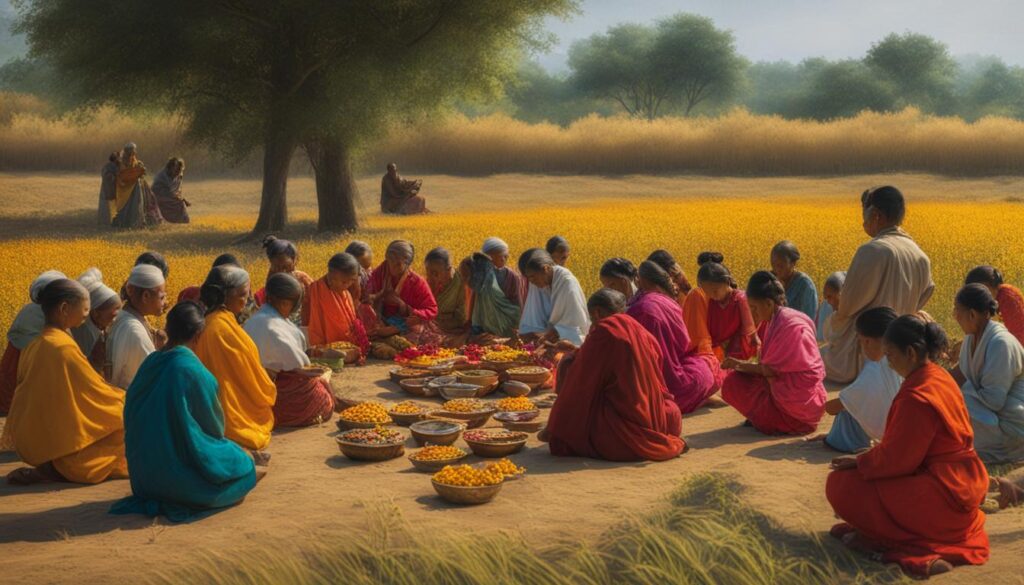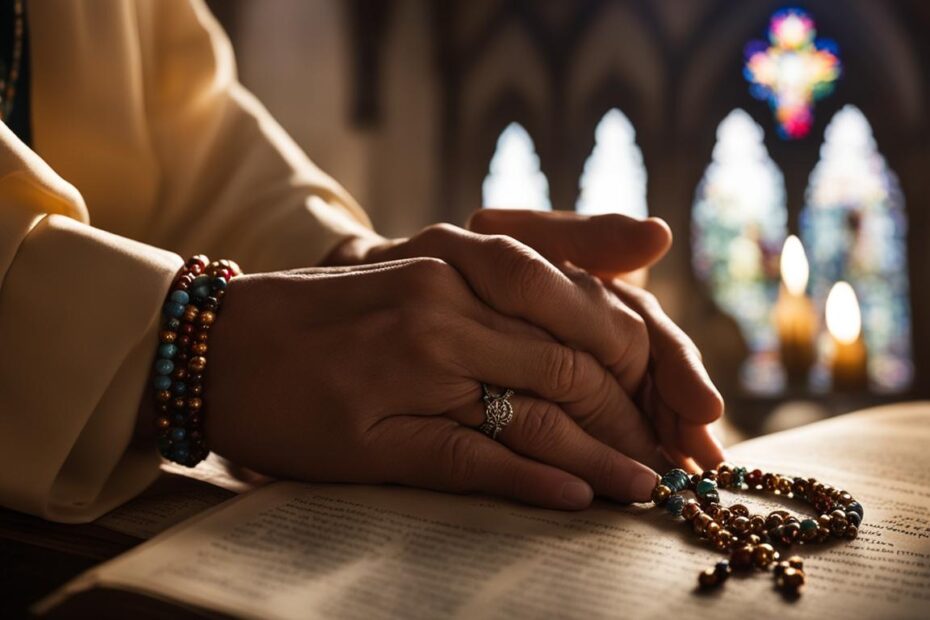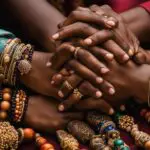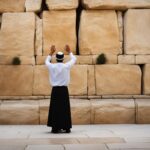In this comprehensive guide, we will delve deep into the rich and diverse world of Christian prayer traditions. Drawing from various sources, we will explore the different prayer practices in Christianity, including the rituals, customs, and historical methods that have shaped the way Christians engage in prayer.
The practice of prayer is an essential part of the Christian faith. Throughout history, Christians have developed unique prayer rituals and customs that reflect their cultural backgrounds and spiritual beliefs. From traditional practices in Western Christianity to ancient traditions in Eastern Orthodox Christianity, prayer serves as a means of connecting with the divine and deepening one’s faith.
In this guide, we will also explore prayer customs in indigenous Christian communities, which highlight the cultural diversity and spiritual rituals within the Christian faith. Additionally, we will take a closer look at African Christian prayer expressions and the vibrant customs that reflect the rich heritage of the continent.
Furthermore, we will delve into the prayer practices of Asian Christianity, where diverse cultures and traditions have influenced the way Christians engage in prayer. By recognizing and appreciating these diverse prayer traditions, we can foster unity and a deeper understanding among Christians, enriching our individual faith journeys.
Key Takeaways:
- Christian prayer traditions encompass a wide range of rituals, customs, and practices.
- Prayer serves as a means of connecting with the divine and deepening one’s faith.
- Indigenous Christian communities and African Christians have developed unique prayer customs that reflect their cultural heritage.
- Asian Christianity incorporates traditional cultural elements into prayer rituals.
- Exploring and embracing diverse prayer traditions fosters unity and enriches individual faith journeys.
Prayer Customs in Western Christianity
Western Christianity embraces a rich tapestry of traditional prayer customs that have shaped the spiritual lives of believers for centuries. These customs serve as an integral part of worship, fostering a deep connection to God and the Christian community. Ritualistic prayers hold a position of prominence in Western Christianity, providing a structured and reverential approach to communication with the divine.
One significant aspect of Western Christian prayer customs is the use of prayer books. These books, such as the Book of Common Prayer, contain a collection of pre-written prayers and liturgies that guide believers in their devotional practices. The act of reciting these prayers allows worshippers to participate in a shared spiritual experience and align themselves with the broader Christian tradition.
While ritualistic prayers hold an essential place, Western Christianity also encourages personal, impromptu prayers as a means of expressing individual devotion. In this way, believers can freely communicate their deepest thoughts, concerns, and gratitude to God, further cultivating their personal relationship with Him.
Prayer is the key in the hand of faith to unlock heaven’s storehouse. – George Mueller
George Mueller’s quote encapsulates the belief held within Western Christian prayer customs – that prayer has the power to unlock the abundant blessings and divine guidance of heaven. Through both structured rituals and heartfelt individual prayers, Western Christianity embraces a comprehensive approach to prayer, fostering a deeper connection with God and nurturing the faith of believers.
| Key Elements | Importance |
|---|---|
| Ritualistic Prayers | Provide a structured and reverential approach to communication with God |
| Prayer Books | Guide believers in their devotional practices and foster participation in shared spiritual experiences |
| Personal, Impromptu Prayers | Enable believers to express individual devotion and cultivate a personal relationship with God |
Prayer Practices in Eastern Orthodox Christianity
Eastern Orthodox Christianity, with its deep roots in ancient Christian prayer traditions, encompasses a unique and rich tapestry of prayer customs. These practices offer adherents a profound means of connecting with the divine and fostering a sense of spiritual transformation. One notable aspect of prayer in Eastern Orthodox Christianity is the use of religious images, which hold a sacred significance and serve as aids in focusing the mind and heart towards God. Icons, for example, are revered as windows into the spiritual realm, inviting believers to enter into a deeper communion with the divine presence.
Aromatic substances also play a significant role in prayer customs within Eastern Orthodox Christianity. Incense, known for its evocative scent and symbolic representation of prayers rising to heaven, is often used during liturgical services and personal devotions. The fragrance of incense permeates the air, creating an atmosphere of reverence and a tangible connection to the sacred.
The repetitive invocation of the ‘Jesus Prayer’ is another distinctive feature of prayer in Eastern Orthodox Christianity. This short prayer, typically recited with a prayer rope, focuses on the name of Jesus and serves as a constant reminder of the presence of Christ and the desire for union with Him. Through the repetition of this prayer, believers seek to immerse themselves in the divine presence, surrendering their thoughts and intentions to God.
Prayer Customs in Eastern Orthodox Christianity:
- Use of religious images, such as icons, to aid in focusing the mind and heart towards God.
- Incorporation of aromatic substances, like incense, to create a sacred atmosphere during liturgical services and personal devotions.
- Repetitive invocation of the ‘Jesus Prayer’ with a prayer rope for a deeper communion with the divine.
The prayer practices in Eastern Orthodox Christianity, with their emphasis on the use of religious images, aromatic substances, and repetitive invocations, provide believers with a powerful means of experiencing the presence of God. These ancient traditions continue to be cherished and upheld by Eastern Orthodox Christians, serving as a source of spiritual nourishment and deepening their connection to the divine.
| Prayer Customs | Key Features |
|---|---|
| Use of religious images | Icons as aids in focusing the mind and heart towards God |
| Aromatic substances | Incense creating a sacred atmosphere during liturgical services and personal devotions |
| Repetitive invocation of the ‘Jesus Prayer’ | Constant remembrance of the presence of Christ and surrendering thoughts to God |
“The use of religious images in Eastern Orthodox Christianity serves as a powerful means of connecting with the divine presence. Icons, in particular, offer a tangible representation of the spiritual realm and invite believers into a deeper communion with God.”
Prayer Traditions in Indigenous Christian Communities
Indigenous Christian communities have developed unique prayer customs that reflect their cultural diversity and spiritual rituals. These communities view prayer as a means of establishing a deep connection with nature and honoring their ancestors. Through prayer, they seek guidance, healing, and spiritual growth, intertwining their cultural heritage with the teachings of Christianity.
Prayer rituals in indigenous Christian communities often incorporate elements of dance, music, and storytelling. These practices create a profound sense of reverence and serve as a way to pass down cultural traditions from generation to generation. The use of traditional instruments, such as drums or flutes, adds a rhythmic dimension to prayer, enhancing the spiritual experience.
Cultural Diversity in Prayer Traditions
The cultural diversity within indigenous Christian communities is reflected in their prayer traditions. Different tribes and regions may have unique prayer practices that align with their specific customs and beliefs. For example, some communities may perform sacred dances as a form of prayer, while others may emphasize communal gatherings and collective prayer. These diverse prayer traditions highlight the rich tapestry of indigenous cultures and their ability to incorporate Christian teachings into their spiritual practices.
By nurturing and preserving their unique prayer customs, indigenous Christian communities maintain a strong sense of identity and connection to their ancestors. Through prayer, they pay homage to their heritage while embracing the teachings of Christianity. This fusion of traditions creates a vibrant and powerful spiritual experience that is deeply rooted in cultural diversity and faith.
| Indigenous Christian Community | Main Prayer Customs |
|---|---|
| Maori (New Zealand) |
|
| Navajo (United States) |
|
| Aboriginal (Australia) |
|
African Christian Prayer Expressions
African Christian prayer customs are rooted in the vibrant and diverse spiritual heritage of the continent. Prayer holds a central place in the daily lives of many African Christians, providing a means of deep connection with the divine. These prayer expressions often take place in communal spaces, homes, and natural settings, creating a sense of reverence and belonging.
The use of music and dance is an integral part of African Christian prayer traditions. These expressive forms of worship create a dynamic and joyful atmosphere, allowing believers to engage both their hearts and bodies in prayer. Through rhythmic movements and harmonious melodies, African Christians enter into a state of collective devotion, offering their prayers with fervor and passion.
“Prayer is our way of communing with God, and it is through our cultural expressions that we find a deeper connection to the divine. The richness of African Christian prayer customs reflects our profound reverence for God and our desire to celebrate His presence in our lives.”
The diversity of African cultures is also reflected in the various prayer rituals and customs. While some communities incorporate traditional African elements, such as drumming or ancestral veneration, others blend indigenous practices with Christian teachings. This fusion of traditions creates a unique and deeply spiritual experience, affirming the cultural identity and faith of African Christians.
| Prayer Practices | Description |
|---|---|
| Call and Response | African Christian prayers often involve call and response patterns, where a leader initiates a prayer or song, and the community responds in unison. This rhythmic dialogue creates a sense of unity and participation. |
| Prayer Circles | Community members gather in circles, holding hands and interlocking arms, as they pray together. This physical connection symbolizes their unity and solidarity in faith. |
| Anointing with Oil | In some African Christian communities, the practice of anointing with oil is incorporated into prayer rituals. This act is believed to invite the presence and blessing of the Holy Spirit. |
table {
width: 100%;
border-collapse: collapse;
}
table th, table td {
border: 1px solid black;
padding: 8px;
}

Christian Prayer in Asia
Christian prayer rituals in Asia are shaped by the cultural diversity and religious traditions of the region. Asian Christianity incorporates unique customs that have evolved over centuries, combining elements of Christian faith with local practices. One such custom is the burning of incense, which is believed to create a sacred atmosphere and symbolize prayers rising to heaven.
In addition to the use of incense, prayer customs in Asian Christianity may also involve specific physical postures. Some believers bow or prostrate themselves as a sign of reverence and humility before God. These actions demonstrate the deep spiritual connection that individuals seek to establish in their prayer life.
Furthermore, chants and mantras hold a significant place in Asian Christian prayer rituals. These repetitive and melodic invocations create a sense of rhythm and spiritual focus, allowing believers to enter into a meditative state. The power of sound is harnessed to enhance the prayer experience and draw individuals closer to the divine.
Table: Prayer Customs in Asian Christianity
| Custom | Description |
|---|---|
| Burning of Incense | Believed to create a sacred atmosphere and symbolize prayers rising to heaven. |
| Physical Postures | Bowing or prostration as a sign of reverence and humility before God. |
| Chants and Mantras | Repetitive and melodic invocations for spiritual focus and meditation. |
The diversity of prayer customs in Asian Christianity reflects the vibrant and rich religious tapestry of the region. These practices offer a unique lens into the intersection of faith and culture, demonstrating the influence of local traditions on the expression of Christian devotion. Through these rituals, Asian Christians find solace, connection, and a deeper sense of spirituality, enriching their religious experience.
Conclusion
The exploration of Christian prayer traditions from around the world reveals a tapestry of spiritual practices that span diverse cultures and countries. From Western Christianity to Eastern Orthodox traditions, indigenous communities, African expressions, and Asian customs, prayer holds a fundamental place in the Christian faith.
By recognizing and appreciating these rich and varied prayer traditions, Christians can foster unity and a deeper understanding among believers. The diversity of prayer practices serves as a reminder of the interconnectedness of the global Christian community.
Today, contemporary Christian prayer practices continue to evolve, incorporating both ancient and modern elements. Through the integration of traditional rituals and the exploration of new forms, believers can experience the transformative power of prayer and cultivate a meaningful relationship with the divine.
Ultimately, embracing the unity in Christian prayer traditions not only enriches individual faith journeys but also strengthens the bond among Christians. By celebrating the vast array of prayer practices, we can create a more inclusive and interconnected Christian community that reflects the beauty of a faith shared by millions around the world.
FAQ
What is the significance of prayer in Christianity?
Prayer is an essential part of the Christian faith, serving as a means of connecting with the divine, expressing devotion, and seeking guidance and support from God.
What are some prayer customs in Western Christianity?
Western Christians often engage in ritualistic prayers, use prayer books as guides, and practice personal, impromptu prayers to express individual devotion.
What are the prayer practices in Eastern Orthodox Christianity?
Eastern Orthodox Christians utilize religious images, aromatic substances, and repetitive invocations like the ‘Jesus Prayer’ to connect with the divine and experience transformation.
How do indigenous Christian communities approach prayer?
Indigenous Christian communities integrate their cultural diversity and spiritual rituals into prayer traditions, often viewing prayer as a means of establishing a relationship with nature and honoring ancestors.
What are African Christian prayer customs like?
African Christians often engage in vibrant and diverse prayer practices, including communal prayers in various settings, accompanied by music and dance, reflecting their rich cultural and spiritual heritage.
What are the prayer traditions in Christian communities in Asia?
In Asia, Christian prayer customs may involve burning incense, bowing or prostration, and reciting chants or mantras, emphasizing the interconnectedness of religious belief and cultural identity.
How can embracing diverse prayer traditions foster unity among Christians?
Recognizing and appreciating the vast array of Christian prayer traditions from around the world can deepen understanding among believers and enrich individual faith journeys, fostering unity in the Christian community.








